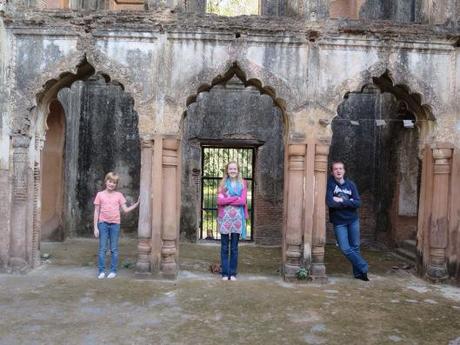Today’s post is an excellent piece by Robynn. I love the way she works through the complexity of facing a culture, familiar to you, yet foreign to your children. And you’ll notice it’s not Friday! Tomorrow I’ll be sending you over to A Life Overseas for my monthly post on that site.

Traveling with Kids by Robynn
We knew it would be an experience taking our three, now very American, children back to India. Two of them were born there but we left when they were 10, 8 and 5. The older two still have memories of India but the younger one really couldn’t remember it all. She was nervous returning. She knew it was an important place, she was born there after all, but she was still anxious.
Our oldest son, Connor really just slipped back in. He remembered the city. Much to our astonishment he still knew his way around. Memories bounced back into his brain faster than he could articulate! It was such a joy to watch him. He came back to who he was.
For my husband and I, returning to India was like putting on our old shoes. We slipped them on and off we went. There was a little chafing where our foot had forgotten that old strap. There were a few moments of uncomfortableness as we got used to wearing sandals again…but really it was all so very familiar and strangely comforting to be there again!
As many of you know, my childhood was spent in Pakistan. Thirteen of our nineteen years of marriage were spent in India. Two of our three babies were born there. I am very at home in South Asia. Parts of me that lay dormant while out of context here in the US suddenly are revived and I find myself more fully alive than ever when I am in India or Pakistan.
For our two daughters, however, it was a different story. Bronwynn just turned 12 years old. She is emotionally intelligent and extremely articulate. Like most children her age, her social filters are limited. Should a thought pop into her head, it will invariably pop out of her mouth. Her experience with India was like most new comers. She loved it. And she hated it. Her running commentary on her own culture shock was hard to take seriously. She made us laugh with the observations she made. She was certainly typical, in that she knew instinctively that her way was the right way. What she saw around her was wrong. She was adamant. Helping her process her experiences took a great deal of discernment and energy. It was nonstop! She couldn’t come to grips with men urinating in public. It didn’t make any sense to her. The horns honking incessantly drove her insane. She spoke to every vehicle that used it’s horn, “Why are you honking? We see you coming. There is no one in your way. Why are you honking? That car can’t possibly move. Look around. See, everyone is stuck. Stop honking!” She was in great angst with these things but it provided a hilarious backdrop to our travels.
The older one, Adelaide, spent the first eight years of her story there. She excelled in Hindi and Bhojpuri, another local language. She started in an Indian school when she was three years old, by the time we took her away from there at age eight she was in Standard 3 and knew her 20 times tables. When we left India she was a little girl. When we returned this December she was a blossoming young, nearly fifteen year old, woman. She is beautiful and tall. Blond hair and hazel eyes, further prove that she isn’t Indian. She felt like a foreigner. She felt the stares of strangers and it made her uncomfortable.
One afternoon we took a cycle rickshaw to a nearby market. As we mounted the rickshaw, she said, “When I was little girl I got stared at because I was cute. Now they are staring at me for different reasons…” My first instinct was to deny it. I hadn’t noticed the stares. My own story makes me oblivious to it, I suppose. I’ve been a foreigner my whole life, being stared at for those foreign-peculiarities is part of that. I didn’t see them seeing us. But then I began to watch. It was true. She was being stared at…some probably because she is so stangely lovely—in a sea of dark hair, her blond hues stand out….other stares were laced with lust and leers. I was horrified. This is my baby. She learned to walk in that place, how dare they now watch her walk. I wanted to protect her. I wanted her to be invisible. I felt in me an odd temptation to somehow quieten her beauty. But it wasn’t her fault. She was modestly attired, well covered. By personality she is reserved. It wasn’t her behavior or her dress that was inviting the jeers. I felt in me a raising familiar feeling from my own childhood. There is no shame in being woman….and yet…there in South Asia it feels like there is. It is the woman’s fault for being curvy and lovely, for having breasts and ankles. My own emotional response to our Adelaide’s observations was visceral and unnerving.
When they were little and we were scooping them up to climb up on to the rickshaw or pushing them into the autos, things were easier. Most problems were solved with a kiss, a cuddle and a Mango Fruity juice box. That life was their normal. They knew nothing different. Taking three (nearly) teenagers, who’s life experiences have widened and somehow narrowed all at the same time, meant bringing along three real people with real hearts and real emotional responses. I expected them to have a wide range of responses but I didn’t anticipate reactions to culture and context. I knew they would remember vague and half-baked moments from when they were little but I had no idea that they might not fully embrace the place in the ways that I did.
In the end, I suppose, I was the most surprised by my own Kid Shock. I was completely taken off guard by the depth of their delights and the weight of their horrors. I have a new appreciation for families that transplant midway through their children’s childhoods. But more importantly I gained a new esteem for my own three prodigy. They handled their shocks and surprises with so much grace and flexibility. They ate new foods without complaining. The girls wore unusual outfits (from their perspective) in an intentional attempt to better enculturate. They spoke English slowly but not condescendingly. Articulating their responses and emotions was difficult but they attempted it. Travel schedules that went awry, trains that were late, unexpected changes to our carefully made plans—all of it was met with maturity and courtesy.
There are hundreds of books and articles written about traveling with your children. For me it was a wonderfully good, impossibly heart-aching, experience. I loved seeing them in that other place. I loved watching their expressions. Most of all, I loved hearing their reactions. Now sitting around our kitchen table here in Kansas, eating supper, I look at their faces again with new appreciation. They are growing up just fine. This trip back to India will always be a part of who they are. It revealed to me more of who they are as people. They are gracious, complex, and kind. They have a capacity to cross cultures gently and with joy.
This gives their Canadian-raised in Pakistan-lived in India-now settled in the US mom great pleasure!


